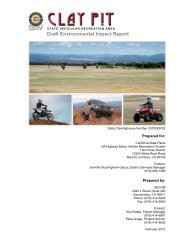continued... - California Off Highway Vehicle Page
continued... - California Off Highway Vehicle Page
continued... - California Off Highway Vehicle Page
Create successful ePaper yourself
Turn your PDF publications into a flip-book with our unique Google optimized e-Paper software.
P A G E 18<br />
Biological Resources<br />
By Peggy Kevin Ponce, Hurley, Environmental Park Maintenance Scientist, Assistant and Joe Hopkins, Environmental Scientist<br />
Habitat Monitoring System—<br />
The Resources Department conducts Habitat Monitoring System (HMS) surveys at both<br />
Ocotillo Wells and Heber Dunes SVRA. These surveys are a way of monitoring animal, plant and<br />
habitat responses to land use by park visitors. As land managers, it is important for the SVRA to<br />
provide recreational opportunities while ensuring adequate protection for plants and animals as<br />
required in the <strong>Off</strong>-<strong>Highway</strong> Motor <strong>Vehicle</strong> Recreation Act. Currently, we are surveying for small<br />
mammals, reptiles, birds, and vegetation.<br />
Small mammal surveys use aluminum live traps called Sherman traps. These traps are small<br />
aluminum boxes with a trap door that springs shut when a rodent or similar-sized animal enters. A<br />
resources staff member checks the traps each morning and records animal species, length, weight, and<br />
trap location. After all information is recorded, the animal is released back into the desert. Reptile<br />
pitfall surveys utilize an array of four five-gallon<br />
buckets buried in the ground to the rim. A series<br />
of wire mesh fencing connects the buckets, acting<br />
as a drift fence corralling lizards, snakes, insects<br />
and the occasional rodent into the traps. Animals<br />
are again weighed, measured and released. OW<br />
will be incorporating new metal mesh snake traps<br />
into our habitat monitoring surveys this year.<br />
These traps are designed specifically for capturing<br />
snakes that hunt across the surface of the desert<br />
at night. The new traps will be used in our pitfall<br />
trapping grids in order to survey the reptiles that<br />
B L O W S A N D R E A D E R<br />
Snake Trap<br />
V O L U M E 7 I S S U E 4<br />
are present at OW. In order to keep members of<br />
the public safe and because the pitfall grids are<br />
State property, please do not tamper with these traps as they could contain venomous snakes. Bird<br />
surveys are based on observation; there is no trapping of birds.<br />
Vegetation surveys are conducted by walking a 100-meter line and recording plant species and<br />
size. These surveys give the SVRA an idea of how OHV use affects plant density and species richness.<br />
Plants are extremely important to monitor because they provide food, shelter and water to the<br />
animals of the desert. Plants also prevent erosion, which can cause dust storms in the arid desert<br />
environment.<br />
If you see our trapping areas when you are out and about, please do not disturb them as we<br />
often leave the buckets and other materials closed, but in place, to save labor. The surveys will start<br />
in late winter and early spring and continue through early summer. Due to budget cutbacks, the<br />
previous summer surveys for the Flat-tailed Horned Lizard will be incorporated into the HMS reptile<br />
surveys. Also, we will be incorporating surveys with control plots in neighboring properties this year.<br />
(Continued on on next page…)








